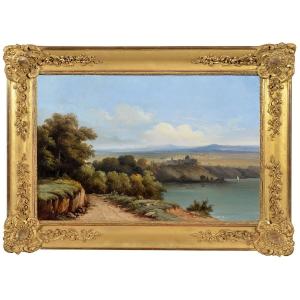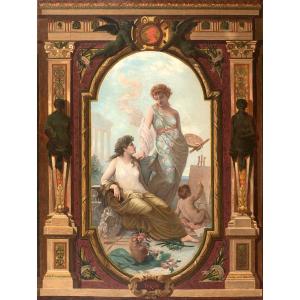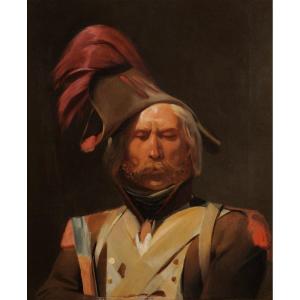(Lyon, 1812 - Lyon, 1885)
Lake Albano, Castel Gandolfo and the Roman countryside
Oil on canvas mounted on cardboard
H. 38 cm; L. 55 cm
Signed lower left
Ponthus-Cinier belongs to what could be defined as the third (and so to speak last) generation of neo-classical or historical landscape painters, born in the years 1810/1820, like Félix Lanoüe, Achille Bénouville, Paul Flandrin, Eugène Ferdinand Buttura and even Alfred de Curzon. More specifically, he is considered the main and most popular representative of the landscape painters of the Lyon school around the middle of the 19th century. Of a generous, honest personality, and pleasant company, Ponthus-Cinier came from a family of merchants on his mother's side and of magistrates on his father's side; intended for trade by his parents, he preferred the artistic path, and after enrolling at the School of Fine Arts in Lyon in 1829, and training in Paris with Paul Delaroche, he exhibited his first works at the Salon de Lyon in 1839 , before taking part in that of Paris in 1841. That same year, he received the second Rome prize for historical landscape (won by Buttura in 1837, and Bénouville in 1845), beaten by Versailles Lanoüe. To perfect his skills, Ponthus-Cinier then decided to go to Italy, alone and at his own expense, for a single stay between 1842 and 1844; he discovered the Ligurian coast, Tuscany, Naples, of course Rome and its surroundings, and executed a considerable amount of studies (painted sketches or pen sketches) which served him to compose views of Italy throughout his career. The main qualities of Ponthus-Cinier probably reside in “the art of lighting a canvas” as A. Jouve wrote in the 19th century, and in his sense of perspective, which is sometimes truly extraordinary; on the other hand, it seems, most of the time, a little less brilliant in the figures and in the transcription of the details. Lake Albano, located south-east of Rome, was one of the favorite sites for visits by artists based in Rome, with in particular Castel Gandolfo, perched on the heights, of which the artist provides us with a relatively schematic view. The view in our painting is presumably taken from the belvedere on the northern shore of the lake, at the foot of the foothills of Monte Cavo. Ponthus-Cinier gives us here a striking proof of his sense of light and perspective.




































 Le Magazine de PROANTIC
Le Magazine de PROANTIC TRÉSORS Magazine
TRÉSORS Magazine Rivista Artiquariato
Rivista Artiquariato